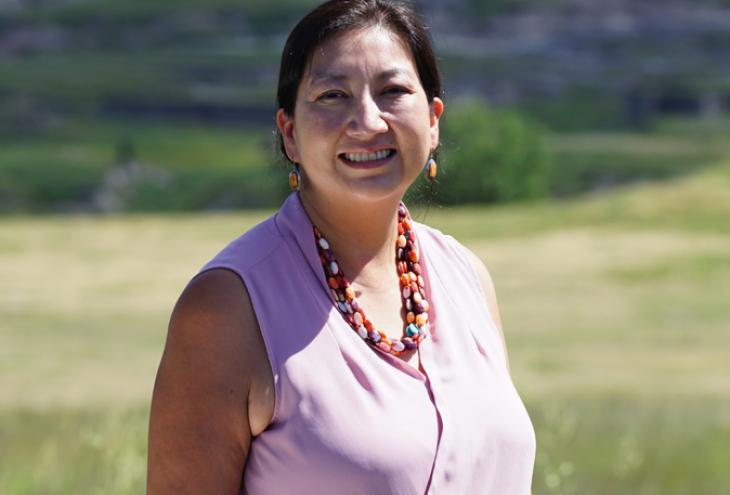Dr. Otakuye Conroy-Ben’s environmental consciousness was awakened at a very young age. Growing up in Porcupine, S.D., on the Pine Ridge Indian Reservation, she could literally taste and smell the impacts people were — or were not — making on the natural world around her.
“I can still taste the water from the reservation. It was clean and not disinfected, and there were no chemicals in it,” says Dr. Conroy-Ben, Oglala Sioux. “I also saw the downside of pollution, where we didn’t have solid waste management and allowed garbage pits to be burned. I remember how much that would burn my eyes and nose.”
Though she didn’t know it as a young child, Dr. Conroy-Ben would devote her life work to researching human impact on the natural world and, in the process, using that understanding to promote the sustainable management of natural resources and better health. Today, Dr. Conroy-Ben is assistant professor of sustainable engineering and the built environment at Arizona State University, a tenure track position that combines teaching, research, and service. A former member of the AISES Board of Directors and an AISES Sequoyah Fellow, Dr. Conroy-Ben is this year’s recipient of the Technical Excellence award.
A focus of Dr. Conroy-Ben’s research is wastewater, a topic she initially became interested in while she was obtaining her PhD in chemical and environmental engineering at the University of Arizona. The U.S. Environmental Protection Agency (EPA) allows municipalities and tribes to discharge sewage into surface water as long as a few contaminants are treated. “I wanted to see about unregulated contaminants that get back into the water cycle because it’s discharged and possibly pulled into drinking water or could impact aquatic animals and recreation,” she says. “There are so many pollutants we don’t know a lot about.”
Dr. Conroy-Ben’s research into wastewater and other topics has been published in a range of respected scientific journals, including Chemosphere, Science of the Total Environment, and Environmental Science and Technology. It also is relevant to policymakers, tribal leaders, regulators, and the general public. “It’s very important in the Southwest and Northwest. As tribes manage more wastewater, it’s important to know the environmental impacts,” she says. “In the Northwest there are tribes that rely heavily on fish as their industry and for consumption. It’s known there are fish that can accumulate pollutants, and so tribes are concerned about wastewater effluent impacting their fish.” Dr. Conroy-Ben does her best to work with tribes so they understand the possible impacts of wastewater, including sharing her findings with the Intertribal Council of Arizona, which runs the largest tribal community wastewater training program.
It’s very important in the Southwest and Northwest. As tribes manage more wastewater, it’s important to know the environmental impacts.
From an early age, Dr. Conroy-Ben knew a few things for sure: that her talent in math and science would lead her to college and that she eventually wanted to do meaningful work. “As I progressed in my academic career, I wanted to study something that would benefit tribal communities,” says Dr. Conroy-Ben. “I didn’t know what, but I knew it would be in the science and engineering field.”
Dr. Conroy-Ben’s parents, grandparents, aunts, and uncles always made it clear that the only real option for her was to go to college. “It was expected,” she says. “If you are good in school, you are going to go far.” An adventurous spirit and desire to see more of the world prompted her to go to South Bend, Ind., where she earned her undergraduate degree in chemistry from the University of Notre Dame. Because there was no AISES chapter on campus, Dr. Conroy-Ben built her own community with the few other Native science and engineering students as well as with other minority students in the sciences.
By the time she was ready for graduate school, Dr. Conroy-Ben wanted to make sure she would be a member of a larger Native student community. “I only applied out West and selected the University of Arizona, which has a lot of Native students pursuing graduate education and plenty of undergrads to mentor,” she says. “That really helped me, not only to talk to others whenever I was struggling in grad school but to have that sense of community, like having drum groups on the quad, and things that remind me of home.”
Today, Dr. Conroy-Ben makes mentoring Native students a top priority, both as a participant in the AISES Lighting the Pathways to Faculty Careers for Natives in STEM program and by bringing in as many Native students as possible to conduct research with her. Even when mentoring and other service projects add to her already extensive workload, Dr. Conroy-Ben doesn’t mind. “It’s important to have a diverse group of mentees in the field, which tends to be white and male,” she says. “I always want to make sure there is a mentor for women and underrepresented minorities, which is why I go out of my way to recruit them into my lab.”













